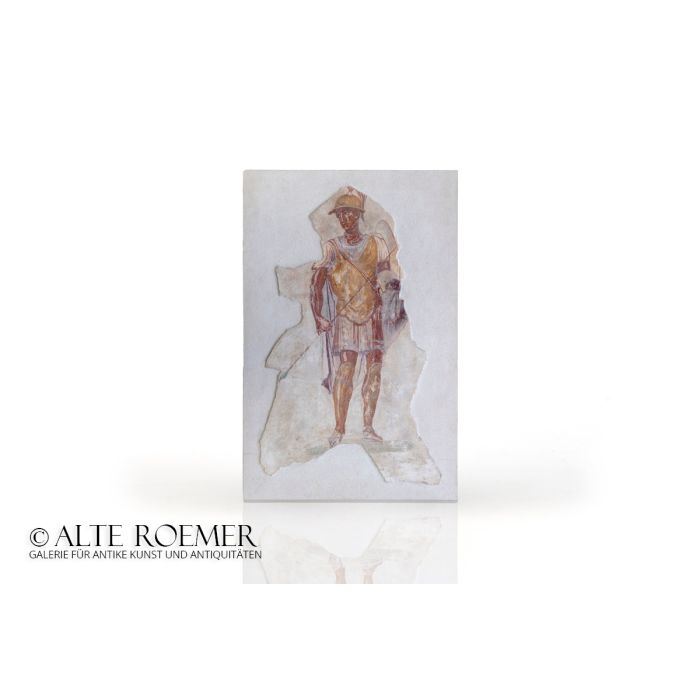Roman wall painting
Price: on request
Sold
Object number
AR3335
| Object: |
Roman wall painting
|
| Material: |
Painted plaster. Mounted on a modern thick plate of porous stone.
|
| Period: |
1st century AD. Third Style of ancient Roman mural painting, also called ornamental style, as described by August Mau. |
| Description: |
Fragment of a Roman wall painting on plaster. The fresco shows a young man in frontal view, painted in pastel tones on a white background. His weight rests on his left leg, his head and gaze turn to the right. The young man wears full military gear, consisting of bronze greaves, body armor with muscles, and a crested helmet. Underneath his armor is a sleeveless Greek-style tunic. He is armed with a spear in the right hand and a short sword attached to the left. On the left shoulder is a round shield, as worn by the cavalry. Due to the long and well-documented history of this fresco, there is no shortage of interpretations of the scene. They range from Mars, the god of war, to Brutus, the murderer of Caesar, to Alexander the Great. What is certain is that the Roman armor is an anachronism. It dates from an earlier period, which can be interpreted as a glorification of the person depicted as a hero or god. Apparently it is not the armor of a simple soldier, but the magnificent armor of a high-ranking military. Although the interpretation as Alexander the Great seems not plausible, the other interpretations mentioned are each well justifiable. The absence of the rest of the scene, in which the character must have been embedded, leaves room for speculation and imagination. We are sure that the new owner will enjoy this freedom as much as previous enthusiasts for this lovely piece. |
| Background: |
We are looking at a typical Roman wall painting, as it was found in the interior of upper-class Roman villas. Only few examples of this type of decoration have survived to this day. Most of these can be found in the buried cities around Mount Vesuvius. Another collection worth mentioning and seeing is housed in the Museo Nazionale Romano, it is based on finds from the immediate vicinity of the museum in Rome. Roman wall paintings in the art trade are a rarity. A specimen of this condition and quality is a once-in-a-decade rarity.
|
| Dimensions: |
The fresco itself 64cm high, 39cm wide. The modern stone slab to which the fresco is applied is 71 cm high, 46 cm wide, 4 cm thick. On the back there are two 36cm long metal rails for hanging the slab on a wall.
|
| Condition: |
Outstanding condition. The fragment itself has a wonderfully preserved painted surface. It consists of a few smaller fragments that have been professionally reassembled and the joints closed. The piece has a history of restoration that can be traced back to 1984. At that time the piece was visibly composed of around ten fragments, with visible joints. Additions were not necessary because the central material consists of belonging original fragments. By 2014, the left shoulder, the round shield and the helmet had been professionally reconstructed, with great expertise for the historically correct addition. The piece was last restored around 2019 by the restorer Darren Bradbury, best known for his restoration of the famous Crosby-Garrett helmet. In the process, some earlier restorations were perfected, for example small pieces on the edge were removed to be closer to the original condition again, and the crest was added. As the main achievement, the delicate layer of plaster was applied stably and securely to a thick slab of porous stone with the possibility of wall mounting. Thus, the piece is ideally prepared for the care of future generations.
|
| Provenance: |
Acquired by us in the UK in 2022. Previously in a New York private collection. Acquired into the collection from Pierre Bergé Paris auction 29 November 2014, lot 255 (estimated at EUR 80,000 to EUR 120,000). Previously in a US private collection. Acquired into the collection from the art trade. The fresco was included in the Sotheby's London auction of 9 July 1984, lot 244. It was probably previously in a private collection. This object has been searched for in the database of Art Loss, comprising more than 500.000 objects claimed stolen or lost. It also integrates the databases of Interpol and FBI. |
| Literature: |
M. J. Klein, Roemische Glaskunst und Wandmalerei (Philipp von Zabern, 1999), pp. 21. A. de Franciscis, The buried cities, Pompeii & Herculaneum (Book Club Associates London, 1968). |
| Authenticity: |
We unconditionally guarantee the authenticity of every artefact, all items are subject to our lifetime return policy on authenticity.
|


